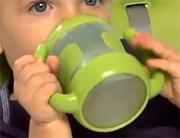
MONDAY, May 14 (HealthDay News) — For babies just starting to move around, walking or running while toting a bottle, a pacifier or a sippy cup might be a dangerous pursuit.
From a nationwide survey, researchers estimated that more than 45,000 visits to the emergency room between 1991 and 2010 in children under 3 years old were because of injuries related to using these products.
Most injuries involved children aged between 1 and 2 years who had a bottle and fell and cut their mouth.
“A lot of parents baby-proof their house but don’t ever think about the possibility of an injury related to these products,” said Sarah Keim, a researcher at Nationwide Children’s Hospital in Columbus, Ohio, and lead author of the study.
The American Academy of Pediatrics recommends that parents transition their children from a bottle to a cup between 12 and 15 months of age to avoid problems such as tooth decay. The AAP also recommends weaning babies off pacifiers between 6 and 12 months.
“Following these recommendations might also help reduce injury, so all the more reason to follow them,” Keim said.
However, parents will not necessarily increase their children’s risk of injury if they don’t wean them off bottles and pacifiers by these ages, said Dr. Mark Zonfrillo, a pediatric emergency medicine physician at the Children’s Hospital of Philadelphia. The current study was not designed to test this possibility.
“I think that the normal reasons why we recommend weaning, which is that bottle-feeding has been associated with excessive milk intake, iron deficiency and possible problems with tooth decay, should be the reasons we focus on weaning,” Zonfrillo said.
But parents can take steps to prevent injuries with these products, such as staying in the same room with their babies once they are mobile, he added.
The study was published online May 14 and appears in the June issue of Pediatrics.
For the study, Keim and her colleagues collected data from the U.S. National Electronic Injury Surveillance System, a network of about 100 hospitals nationwide that record injuries in their emergency departments related to consumer products.
The system recorded 2,283 cases of bottle, pacifier and sippy-cup injuries in children younger than 3 years between 1991 and 2010.
From that number, the researchers estimated there were 45,398 cases of these injuries nationwide during this period of time, or 2,270 cases a year on average.
Two-thirds of the injuries were in children between 1 and 2 years. “This is right around the time that kids start to walk and run and aren’t very good at it yet,” Keim said.
About 66 percent of the injuries were related to a bottle, and 86 percent involved a fall.
Although the researchers were unable to determine the exact injury sequence of events, “we suggest that a reasonable scenario would be a child walking or running with a product in their mouth or near their face and tripping and falling,” Keim said.
It is not clear why more injuries were associated with bottles than the other products, Keim said. “There could be something about the products themselves that are potentially more dangerous or that children are using them more.”
Injuries related to pacifiers made up about 20 percent of cases. They occurred most often in children under 1 year old and led to bruising and dental damage. Sippy-cup injuries, which were most common in children older than 2 years, were more likely to affect the head, neck and face.
Serious injuries were rare. Seven deaths related to these products were recorded during this time, which the authors did not include in the study.
Out of the estimated injuries, there were 1,321 cases of swallowing or inhaling the product, 1,895 burns and 1,821 other injuries like fractures.
The authors also found that the rates of injuries with these products decreased 41 percent over the time frame studied.
“A lot of this decrease was related to decreases in bottle use so it could be because children are breast-feeding longer or are transitioning to sippy cups earlier,” Keim said.
Keim said it was reassuring to see that choking injuries made up a small portion of overall injuries.
For his part, Zonfrillo said, “It was interesting to see all the types of injuries grouped together.”
The type of injury that was very prevalent in this study was also very minor, he added.
Having children stay seated while drinking
may help protect them, the authors said.
More information
To learn more about child product safety, visit Keeping Babies Safe.

